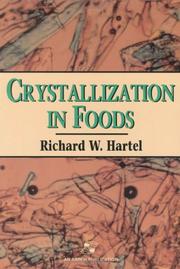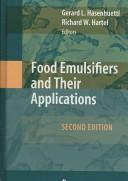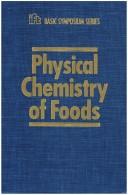| Listing 1 - 10 of 23 | << page >> |
Sort by
|

ISBN: 0834216345 Year: 2001 Publisher: Gaithersburg Aspen
Abstract | Keywords | Export | Availability | Bookmark
 Loading...
Loading...Choose an application
- Reference Manager
- EndNote
- RefWorks (Direct export to RefWorks)
Crystallization --- Food --- Food texture
Book
ISBN: 1461493838 146149382X Year: 2014 Publisher: New York, NY : Springer New York : Imprint: Copernicus,
Abstract | Keywords | Export | Availability | Bookmark
 Loading...
Loading...Choose an application
- Reference Manager
- EndNote
- RefWorks (Direct export to RefWorks)
This delicious new book reveals the fascinating science behind some of our favorite candies. If you’ve ever wondered how candy corn is made, or whether Baby Ruth bars really float, as in the movie Caddyshack, then this engaging collection of food for thought is guaranteed to satisfy your hunger for knowledge. As well as delving into candy facts and myths such as the so-called ‘sugar high’, and the long history of making sweetmeats, the authors explore the chemistry of a candy store full of famous treats, from Tootsie Rolls to Pixy Styx and from Jawbreakers to Jordan Almonds. They reveal what makes bubble gum bubbly and why a Charleston Chew is so chewy. Written in an engaging, accessible, and humorous style that makes you laugh as you learn, Candy Bites doesn’t shy away from the hard facts, or the hard questions, about candy. It tackles the chemistry of hydrocolloids in gummy bears alongside the relationship between candy and obesity, and between candy and dental cavities. The chapters open a window on the commercial and industrial chemistry of candy manufacture, making this book a regular Pez dispenser of little-known, yet captivating factoids. About the Authors: Richard Hartel is a Professor of Food Science at the University of Wisconsin. In addition to an active research program and teaching numerous undergraduate classes, he teaches an annual summer candy course co-sponsored with the candy industry. He was given the Stroud-Jordan award in 2012 from the American Association of Confectionery Technologists for his contributions to the industry. AnnaKate Hartel is a graduate of Northland College in Ashland, Wisconsin. She currently lives in Cedar Rapids, Iowa and is pursuing a career in education assessment. Her favorite candy is the Snickers bar.
Candy industry --- Chemistry --- Analysis. --- Physical sciences --- Food industry and trade --- Food science. --- Science (General). --- Food Science. --- Popular Science, general. --- Science --- Food—Biotechnology. --- Popular works.
Book
ISBN: 9780387758459 0387758445 9780387758442 9786612037696 1282037692 0387758453 Year: 2008 Publisher: New York, NY : Copernicus Books,
Abstract | Keywords | Export | Availability | Bookmark
 Loading...
Loading...Choose an application
- Reference Manager
- EndNote
- RefWorks (Direct export to RefWorks)
Food Bites is an easy-to-read, often humorous book on the scientific basis of the foods we eat, and answers those pesky, niggling questions such as: Is the quality of beer really affected by the type of water used? and Processed foods: good or bad? Readers will be captivated by this superbly written book, especially so as their guides are Professor Richard Hartel, professor of Food Engineering at UW-Madison, along with his daughter, AnnaKate Hartel. Professor Hartel has for the last four years penned a witty and illuminating column on all aspects of food science for the Capital Times of Madison, and his weekly wisdom has now been collected into a single publication. With a huge and growing interest in the science of food, this treasure trove of knowledge and practical information, in 60 bite-sized chunks, is sure to be a bestseller.
Chemistry. --- Food Science. --- Chemistry/Food Science, general. --- Popular Science, general. --- Food science. --- Science (General). --- Chimie --- Food --Composition. --- Food. --- Food --- Health & Biological Sciences --- Diet & Clinical Nutrition --- Composition --- Composition. --- Chemistry of food --- Food, Chemistry of --- Food chemistry --- Foods --- Chemistry --- Popular works. --- Biotechnology. --- Dinners and dining --- Home economics --- Table --- Cooking --- Diet --- Dietaries --- Gastronomy --- Nutrition --- Analysis --- Physical sciences --- Science --- Food—Biotechnology. --- Primitive societies
Book
ISBN: 8847011744 9786613003683 1283003686 8847011752 Year: 2009 Publisher: Milano : Springer Milan,
Abstract | Keywords | Export | Availability | Bookmark
 Loading...
Loading...Choose an application
- Reference Manager
- EndNote
- RefWorks (Direct export to RefWorks)
Cosa mangia l’America nell’era moderna? Probabilmente molte delle cose che mangeremo anche noi nel prossimo futuro. Ormai la dinamica dei flussi è chiara: l’hamburger e la Coca Cola sono solo i simboli di un modello di consumo che, con diverse sfaccettature, ha definitivamente contaminato la nostra cultura del cibo. Se per noi gli spaghetti sono intoccabili e la pizza continua a essere il più gettonato tra i fast food, è comunque vero che le giovani generazioni sentono irresistibile il richiamo del cibo made in USA. All’insegna dell’intercultura e del mercato globale, ci troveremo sempre di più a fare i conti con prodotti per noi alieni come i Marshmallow (le famose caramelle spugnose a forma di cilindretto), magari in versioni addomesticate per sposarsi meglio con il gusto mediterraneo. Del resto il Parmigiano Reggiano e lo Speck dell’Alto Adige negli hamburger di McDonald’s sono già una realtà ed è un dato di fatto che i banchi del supermercato si arricchiscano ogni giorno di nuove proposte sempre più tecnologiche. Le "patatine" che hanno l’aspetto e il sapore del bacon (senza averlo mai visto nemmeno da lontano) sono dei must dell’happy hour, così come prosegue il successo degli energy drink dal gusto dubbio e delle gomme americane (per l’appunto…) che frizzano. È giusto? È salutare? Chissà… Di sicuro c’è una cosa: è la realtà dei nostri giorni. E allora, perché non provare a conoscerla meglio? Perché non lasciare da parte diffidenze e pregiudizi per dare spazio alla pura e semplice curiosità? Pagina dopo pagina, questo libro ci introduce in un mondo diverso ma certamente affascinante, dove si scopre che il cibo può avere dimensioni e significati differenti da quelli che gli attribuiamo abitualmente. Oltre il piacere, oltre il nutrimento, diventa gioco, ricerca tecnologica, sfida scientifica, desiderio di stupire e di distinguersi… Gli autori, esperti riconosciuti del settore, si approcciano a questo mondo con piacevole ironia e distacco professionale, guidandoci alla scoperta dei Pixy Stix, piuttosto che dei Circus Peanuts e dei Lucky Charm, senza peraltro trascurare argomenti più vicini al nostro quotidiano, dalla preparazione del gelato alla conservazione sotto vuoto, alle indispensabili attenzioni igieniche da seguire in cucina. Leggendo, si ha conferma di come l'alimentazione sia davvero una scienza complessa e di quanto siano ampi e stimolanti gli orizzonti che apre alla ricerca, ma si ha anche la percezione netta di quanta distanza possa esserci tra le diverse culture alimentari. Il mondo è bello perché è vario. È vero: la diversità è una ricchezza. Ma perché lo sia veramente va approcciata con curiosità e desiderio di confronto, gli stessi atteggiamenti che scaturiscono in modo irresistibile dalla lettura di questo libro. "Se avete un interesse per l’alimentazione, sarà un’appetitosa lettura" Linda Brazill, The Capital Times.
Food -- Composition. --- Food -- Microbiology. --- Nutrition. --- Physical Sciences & Mathematics --- Health & Biological Sciences --- Diet & Clinical Nutrition --- Sciences - General --- Food --- Composition. --- Analysis. --- Analysis of food --- Chemistry of food --- Food, Chemistry of --- Food chemistry --- Chemistry --- Popular works. --- Chemistry. --- Popular Science. --- Popular Science, general. --- Chemistry/Food Science, general. --- Food Science. --- Biotechnology. --- Chemistry, Technical --- Sanitary chemistry --- Composition --- Analysis --- Science (General). --- Food science. --- Science --- Physical sciences --- Food—Biotechnology.
Digital
ISBN: 9788847011755 Year: 2009 Publisher: Milano Springer Milan
Abstract | Keywords | Export | Availability | Bookmark
 Loading...
Loading...Choose an application
- Reference Manager
- EndNote
- RefWorks (Direct export to RefWorks)
Science --- Food science and technology --- popularisering wetenschap --- voedingschemie --- voedingsleer
Digital
ISBN: 9781461493839 Year: 2014 Publisher: New York, NY Springer, Imprint: Copernicus
Abstract | Keywords | Export | Availability | Bookmark
 Loading...
Loading...Choose an application
- Reference Manager
- EndNote
- RefWorks (Direct export to RefWorks)
This delicious new book reveals the fascinating science behind some of our favorite candies. If you’ve ever wondered how candy corn is made, or whether Baby Ruth bars really float, as in the movie Caddyshack, then this engaging collection of food for thought is guaranteed to satisfy your hunger for knowledge. As well as delving into candy facts and myths such as the so-called ‘sugar high’, and the long history of making sweetmeats, the authors explore the chemistry of a candy store full of famous treats, from Tootsie Rolls to Pixy Styx and from Jawbreakers to Jordan Almonds. They reveal what makes bubble gum bubbly and why a Charleston Chew is so chewy. Written in an engaging, accessible, and humorous style that makes you laugh as you learn, Candy Bites doesn’t shy away from the hard facts, or the hard questions, about candy. It tackles the chemistry of hydrocolloids in gummy bears alongside the relationship between candy and obesity, and between candy and dental cavities. The chapters open a window on the commercial and industrial chemistry of candy manufacture, making this book a regular Pez dispenser of little-known, yet captivating factoids. About the Authors: Richard Hartel is a Professor of Food Science at the University of Wisconsin. In addition to an active research program and teaching numerous undergraduate classes, he teaches an annual summer candy course co-sponsored with the candy industry. He was given the Stroud-Jordan award in 2012 from the American Association of Confectionery Technologists for his contributions to the industry. AnnaKate Hartel is a graduate of Northland College in Ashland, Wisconsin. She currently lives in Cedar Rapids, Iowa and is pursuing a career in education assessment. Her favorite candy is the Snickers bar.
Science --- Chemistry --- Food science and technology --- obesitas --- popularisering wetenschap --- chemie --- wetenschap --- voedingsleer --- wetenschappen

ISBN: 1281275921 9786611275921 0387752846 0387752838 1441925902 Year: 2008 Publisher: New York : Springer,
Abstract | Keywords | Export | Availability | Bookmark
 Loading...
Loading...Choose an application
- Reference Manager
- EndNote
- RefWorks (Direct export to RefWorks)
Thoroughly revised and updated, the second edition of Food Emulsifiers and their Applications integrates theoretical background with practical orientation and serves as the definitive reference on subject. It offers practitioners an overview of the manufacture, analysis, physical properties, interactions and applications of emulsifiers used in processed food. Written for food technologists as well as R & D and product development personnel, begins with the design and preparation of emulsifiers (including interactions with other food ingredients), which leads in to product categories, including dairy, infant nutrition, bakery, confectionery, and margarine, followed by nutrition improvement and processing techniques. Gerard L. Hasenhuettl is a consultant in Port Saint Lucie, Florida. Richard W. Hartel is a Professor of Food Engineering in the Department of Food Science at the University of Wisconsin, Madison, Wisconsin.
Food additives. --- Dispersing agents. --- Chemical dispersants --- Dispersing chemicals --- Dispersants --- Chemicals --- Additive compounds --- Additives, Food --- Chemical additives in food --- Enriched foods --- Food science. --- Chemistry. --- Chemistry, Physical organic. --- Food Science. --- Chemistry/Food Science, general. --- Physical Chemistry. --- Physical sciences --- Science --- Chemistry, Physical organic --- Chemistry, Organic --- Chemistry, Physical and theoretical --- Food—Biotechnology. --- Physical chemistry. --- Chemistry, Theoretical --- Physical chemistry --- Theoretical chemistry --- Chemistry

ISBN: 0824786939 Year: 1992 Publisher: New York Marcel Dekker
Abstract | Keywords | Export | Availability | Bookmark
 Loading...
Loading...Choose an application
- Reference Manager
- EndNote
- RefWorks (Direct export to RefWorks)
Physicochemistry --- fysicochemie --- Human biochemistry --- Nutritionary hygiene. Diet --- Produit alimentaire --- foods --- Propriété physicochimique --- chemicophysical properties --- Émulsion --- Emulsions --- Gélification --- Jellification --- Propriété rhéologique --- Rheological properties --- Traitement thermique --- Heat treatment --- Propriété organoleptique --- Organoleptic properties --- Valeur nutritive --- Nutritive value --- Oxydation --- Oxidation --- Activité enzymatique --- Enzyme activity --- Défaut --- Defects --- Brunissement --- Browning --- Emulsions.
Book
ISBN: 9780387773919 0387773908 9780387773902 9786612923982 1282923986 0387773916 Year: 2008 Publisher: New York : Springer,
Abstract | Keywords | Export | Availability | Bookmark
 Loading...
Loading...Choose an application
- Reference Manager
- EndNote
- RefWorks (Direct export to RefWorks)
Careers in Food Science provides detailed guidelines for students and new employees in the food industry to ensure a successful start to their career. Every step towards a rewarding career in this rapidly evolving industry is covered, from which classes to take in college and which degrees to earn, to internships, and finally how to land, and keep, the first job. This book also provides day-to-day examples of what to expect from the many jobs available to help students decide what to do and where to go. The food industry includes a wide array of fields and careers not only in food production and in academia, but also in government and research institutions. In fact, it is estimated that by 2010 there will be 52,000 annual job openings for college graduates in the Food, Agriculture, and Natural Resources system in the U.S. alone. Written by people who have experience or are currently working in each sector, this book seeks to shed some light on starting, or furthering, a career in this exciting field. Richard W. Hartel is a Professor of Food Engineering in the Department of Food Science at the University of Wisconsin, Madison, Wisconsin. Christina P Klawitter is Assistant Dean & Director, Career Services, in the College of Agricultural & Life Sciences at the University of Wisconsin, Madison, Wisconsin.
Chemistry. --- Food Science. --- Chemistry/Food Science, general. --- Food science. --- Chimie --- Food -- Research -- Vocational guidance. --- Food industry and trade -- Vocational guidance. --- Food. --- Nutrition. --- Food industry and trade --- Health & Biological Sciences --- Chemical & Materials Engineering --- Chemical Engineering --- Biomedical Engineering --- Engineering & Applied Sciences --- Vocational guidance --- Vocational guidance. --- Food preparation industry --- Food processing industry --- Food trade --- Food --- Biotechnology. --- Food processing --- Food technology --- Agricultural processing industries --- Processed foods --- Processing --- Physical sciences --- Science --- Food—Biotechnology.
Book
ISBN: 1489986634 1461460956 1461460964 129919737X Year: 2013 Publisher: New York : Springer,
Abstract | Keywords | Export | Availability | Bookmark
 Loading...
Loading...Choose an application
- Reference Manager
- EndNote
- RefWorks (Direct export to RefWorks)
Ice Cream, 7th Edition focuses on the science and technology of frozen dessert production and quality. It explores the entire scope of the ice cream and frozen dessert industry, from the chemical, physical, engineering and biological principles of the production process to the distribution of the finished product. It is intended for industry personnel from large to small scale processors and suppliers to the industry and for teachers and students in dairy or food science or related disciplines. While it is technical in scope, it also covers much practical knowledge useful to anyone with an interest in frozen dessert production. World-wide production and consumption data, global regulations and, as appropriate, both SI and US units are provided, so as to ensure its relevance to the global frozen dessert industry. This edition has been completely revised from the previous edition, updating technical information on ingredients and equipment and providing the latest research results. Two new chapters on ice cream structure and shelf-life have been added, and much material has been rearranged to improve its presentation. Outstanding in its breadth, depth and coherence, Ice Cream, 7th Edition continues its long tradition as the definitive and authoritative resource for ice cream and frozen dessert producers. H. Douglas Goff is a Professor of Food Science at the University of Guelph, Canada. He has been teaching and conducting research in ice cream science and technology for more than 30 years. Richard W. Hartel is a Professor of Food Engineering in the Department of Food Science at the University of Wisconsin-Madison, USA. He has over 20 years of experience working on the structural attributes of ice cream.
Dairy processing. --- Dairy products. --- Ice cream industry. --- Ice cream, ices, etc. --- Ice cream, ices, etc --- Health & Biological Sciences --- Biomedical Engineering --- Ices --- Chemistry. --- Food --- Carbohydrates. --- Food Science. --- Carbohydrate Chemistry. --- Biotechnology. --- Confectionery --- Frozen desserts --- Banana splits --- Milkshakes --- Sundaes --- Food science. --- Carbs (Carbohydrates) --- Biomolecules --- Organic compounds --- Glycomics --- Science --- Food—Biotechnology.
| Listing 1 - 10 of 23 | << page >> |
Sort by
|

 Search
Search Feedback
Feedback About UniCat
About UniCat  Help
Help News
News